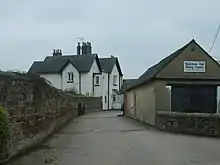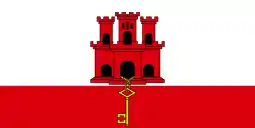Thomas Fowke
Lieutenant General Thomas Fowke, also spelt Foulks, circa 1690 to 29 March 1765, was a British military officer of the 18th century. He was Governor of Gibraltar from 1753 to 1756, and twice court-martialled during his service.
Lieutenant General Thomas Fowke | |
|---|---|
 The Fowke family home, Gunstone Hall | |
| Born | c. 1690 Gunstone, South Staffordshire |
| Died | 29 March 1765 Bath |
| Allegiance | |
| Service/ | British Army |
| Years of service | 1702–1756 |
| Rank | Lieutenant General |
| Commands held | Governor of Gibraltar 1753–1756 |
| Battles/wars | War of the Spanish Succession Almanara Saragossa; Villaviciosa War of the Austrian Succession 1745 Jacobite Rising Prestonpans Seven Years' War |
| Relations | Sir Frederick Fowke (1782–1856) George Mason, 1725 to 1792 |
The first followed defeat at Prestonpans in the 1745 Jacobite Rising, when he was acquitted. As Governor of Gibraltar, he was court-martialled again for his part in the 1756 Battle of Minorca, a defeat that led to the execution of Admiral Byng.
Sentenced to nine months suspension, despite minimal responsibility for the defeat, George II insisted he be dismissed from the army. This ended his career, although he was reinstated as Lieutenant General following the accession of George III in 1761. He died in Bath in March 1765.
Fowke's great-uncle emigrated to Virginia in 1651, and he was closely related to George Mason, 1725 to 1792, one of the Founding Fathers of the United States. Mason built a house he named Gunston Hall, after the family home in Gunstone, South Staffordshire; it is now an historic monument.
Life
Thomas Fowke was the elder son of Thomas Fowke (ca 1645–1708) and his second wife Mary (ca 1650–1705), born in 1690 near Gunstone, South Staffordshire. He had two sisters, Mary and Martha; his younger brother Edmund (1704–1784) became a Rear-admiral.[1]
He was married twice, first to Elizabeth Ingoldsby (ca 1705–1735), with whom he had a daughter, Theophila Lucy (1724–1734). In 1747, he married Dorothea Randall (ca 1732–1788); they had two children, another Theophila (ca 1745–1756), and Sir Thomas Fowke (1744–1786). His grandson was Sir Frederick Fowke (1782–1856).[2]
He died in Bath, England in March 1765.
Career

Fowke began his military career during the War of the Spanish Succession in 1702 as an Ensign in Nicholas Lepell's Regiment of Foot, his father being a captain in the same unit.[3] Until the late 19th century, commissions could be purchased or sold; in June 1707, he became captain after exchanging positions with his father, who died in June 1708.[4]
Peregrine Lascelles, who later served with Fowke in the 1745 Rising, was a captain in the same regiment. In 1710, the unit served in Spain, a last effort to win the Spanish throne for Archduke Charles of Austria.[5] Despite victories at Almanara and Saragossa, the Allies were defeated at Villaviciosa in December. The regiment suffered heavy losses; Lepell, by then the senior British officer in Catalonia, reported losses of 107 men after the battle.[6]
Villaviciosa ended the campaign in Spain, and Lepells was disbanded in November 1712 as the army was reduced prior to the 1713 Peace of Utrecht.[7] Fowke managed to retain his commission, transferring into Whetham's, later 27th Foot, before joining Cotton's Foot, later Somerset Light Infantry in 1716, as a Major. In June 1722, he was commissioned as Lieutenant-Colonel Kerr's Dragoons, later 11th Hussars, a position he retained until late 1740.[8]
The period of comparative peace after 1713 ended with the outbreak of the War of the Austrian Succession, and in January 1741, Fowke became Colonel of a new regiment, the 43rd Foot. He exchanged into the Queen's Royal Regiment, then based in Scotland, and promoted Brigadier General in June 1745, three months before the 1745 Jacobite Rising.[9]
As deputy to Sir John Cope, military commander in Scotland, he fought at Prestonpans in September; their army collapsed in the face of the Jacobite assault, in a battle lasting less than 15 minutes. Fowke commanded two regiments of dragoons, who fled without firing a shot, and halted only when they reached Berwick-upon-Tweed. He, Cope and Lascelles were later tried by a court-martial in 1746; while all three were exonerated, Cope never held command again.[10]
Fowke was posted to Flanders and became a Major General in 1747, shortly before the 1748 Treaty of Aix-la-Chapelle followed by an appointment as Governor of Gibraltar in 1752. The opening action of the Seven Years' War was the British naval defeat at Minorca in June 1756, an event that led to the trial and execution of Admiral John Byng.[11]
Fowke was court martialled for allegedly refusing to provide Byng with soldiers from the Gibraltar garrison; originally suspended for nine months, George II insisted he be dismissed from the army. Both he and Byng were viewed as unfairly singled out for a defeat brought about by general neglect. A 1757 Parliamentary committee noted the poor state of the island's defences, with crumbling walls and rotten gun platforms; over 35 senior officers were absent from their posts, including the governor and colonels of all four regiments in its garrison.[12]
This ended his career, although his rank was reinstated when George III succeeded in 1761.[13]
Legacy

In 1651, Thomas Fowke's great-uncle Gerard moved to Virginia, along with his cousin, Philip Mason; one of their descendants was George Mason (1725–1792), a US Founding Father. In 1755, he commemorated his family roots by building a new house in Virginia named Gunston Hall; in 1923, another Mason built a second Gunston Hall, in North Carolina.[14]
Fowke kept a personal journal and record of correspondence; his papers for the period 1752 to 1755, including his time as Governor of Gibraltar, were acquired by in 2015 by the Lewis Walpole Library, part of Yale University.[15]
After his retirement, he lived near Park Hill, Yorkshire, now the site of the Park Hill estate, Sheffield, which was given listed building status in 1998.[16]
References
- "Rear-Admiral Edmund Thorpe Fowke". The Peerage. Retrieved 2 June 2020.
- "Lt.-Gen. Thomas Fowke". The Peerage. Retrieved 2 June 2020.
- Dalton 1903, p. 269.
- Dalton 1904, p. 189.
- Dalton 1904, p. 243.
- Tumath 2013, p. 185.
- Adjutant General's Office 1842, p. 84.
- Leslie 1916, p. 123.
- Cannon 1837, p. 31.
- Blaikie 1916, p. 434.
- Regan 2000, p. 35.
- Debrett 1792, p. 295.
- Dalton 1904, p. 269.
- La Raia.
- "Papers of Lieutenant-General Thomas Fowke". Lewis Walpole Library. 2 August 2016. Retrieved 9 February 2019.
- NHLE 1246881.
Sources
- Adjutant General's Office (1842). Historical Records of the British Army; History of the 13th Light Dragoons. John W Parker.
- Blaikie, Walter Biggar, ed. (1916). Publications of the Scottish History Society (Volume Series 2, Volume 2 (March, 1916) 1737–1746). Scottish History Society.
- Cannon, Richard (1837). Historical Record of the Second, Or Queen's Royal Regiment of Foot. William Clowes.
- Dalton, Charles (1903). English army lists and commission registers, 1661–1714 Volume V. Eyre and Spottiswood.
- Dalton, Charles (1904). English army lists and commission registers, 1661–1714 Volume VI. Eyre and Spottiswood.
- Debrett (1792). History, Debates & Proceedings of Parliament 1743–1774; Volume III. Debrett.CS1 maint: ref=harv (link)
- "Fowke". The Peerage. Retrieved 9 February 2019.
- La Raia, Jackie. "George Mason's Gunston Hall". Gunston Hall Blog (Virginia). Retrieved 9 February 2019.
- Leslie, JH (1916). Notes and Queries, 12th Series, Volume II. Frank Chance.
- Historic England, "Park Hill (Grade II) (1246881)", National Heritage List for England, retrieved 1 June 2020
- "Papers of Lieutenant-General Thomas Fowke". Lewis Walpole Library. Retrieved 9 February 2019.
- "Rear-Admiral Edmund Thorpe Fowke". The Peerage. Retrieved 2 June 2020.
- "Lt.-Gen. Thomas Fowke". The Peerage. Retrieved 2 June 2020.
- Regan, Geoffrey (2000). Brassey's Book of Naval Blunders. Brassey's.
- Tumath, Andrew (2013). "The British Army in Catalonia after the Battle of Brihuega 1710–1712". Journal of the Society for Army Historical Research. 91 (367): 182–205. JSTOR 44232207.
| Government offices | ||
|---|---|---|
| Preceded by Humphrey Bland |
Governor of Gibraltar 1753–1756 |
Succeeded by Lord Tyrawley |
| Military offices | ||
| Preceded by None |
Colonel of Thomas Fowke's Regiment of Foot 1741 |
Succeeded by William Graham |
| Preceded by Percy Kirke |
Colonel of The Queen's Own Royal Regiment of Foot 1741–1755 |
Succeeded by John Fitzwilliam |
| Preceded by Edward Braddock |
Colonel of the 14th Regiment of Foot 1755–1756 |
Succeeded by Charles Jeffereys |


